The Perito Moreno glacier is a natural wonder in Argentina made of big, blue, beautiful ice. In fact, this stunning glacier covers more surface area than the entire city of Buenos Aires.
You can see this Patagonian glacier from a metal walkway that spans the edge of the lake, or there are even glacier trekking tours so you can hike on top of the ice with a local guide!
Needless to say, seeing this glacier and hiking on it is an amazing experience, and it’s very popular with tourists coming to the Los Glaciares National Park. It’s also surprisingly easy to do on a day trip from the town of El Calafate, in Argentina’s southern Patagonia region.
This travel guide will explain how to get to Perito Moreno glacier from El Calafate (with or without a tour), and how to do the glacier trek. Then, I’ll share some interesting facts about the glacier itself!
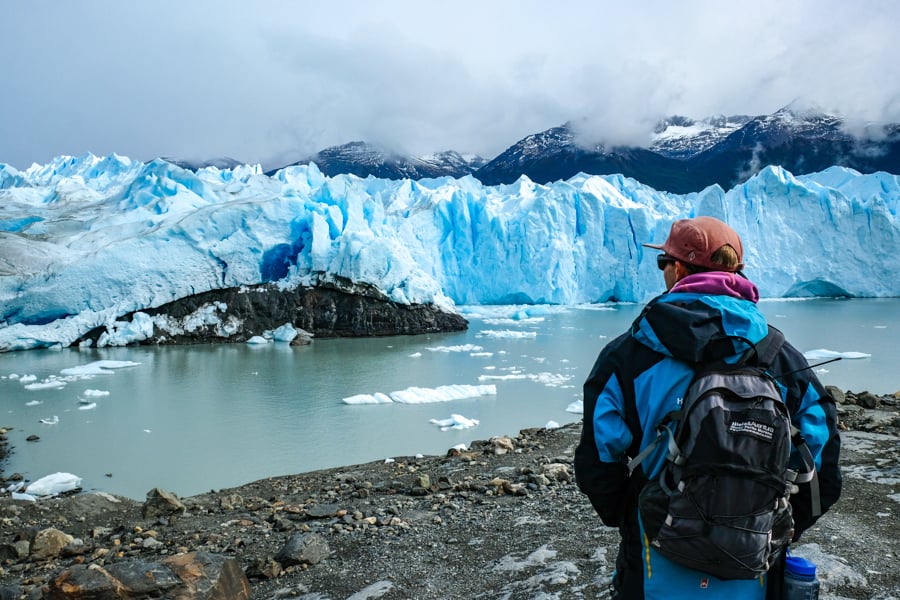
Getting ready to hike the Perito Moreno glacier. Epic!
Where Is Perito Moreno Glacier?
The Perito Moreno glacier is located on Lake Argentino, near the town of El Calafate, in Argentina’s famous Patagonia region.
El Calafate is a tourist friendly town with lots of comfy hotels and good restaurants, so it’s a great place to base yourself for visiting the Perito Moreno glacier and other sights in Patagonia.
How To Get To Perito Moreno Glacier
The closest airport to the Perito Moreno glacier is the small international airport in El Calafate (FTE), which has direct flights from Buenos Aires, Cordoba, Ushuaia, and other places.
The flight from Buenos Aires to El Calafate takes about 3 hours and it’s offered by multiple airlines, with pretty reasonable prices. There are two airports in Buenos Aires (AEP or EZE) and you can use either of them to fly here.
You can shop for flights to Argentina on Skyscanner.
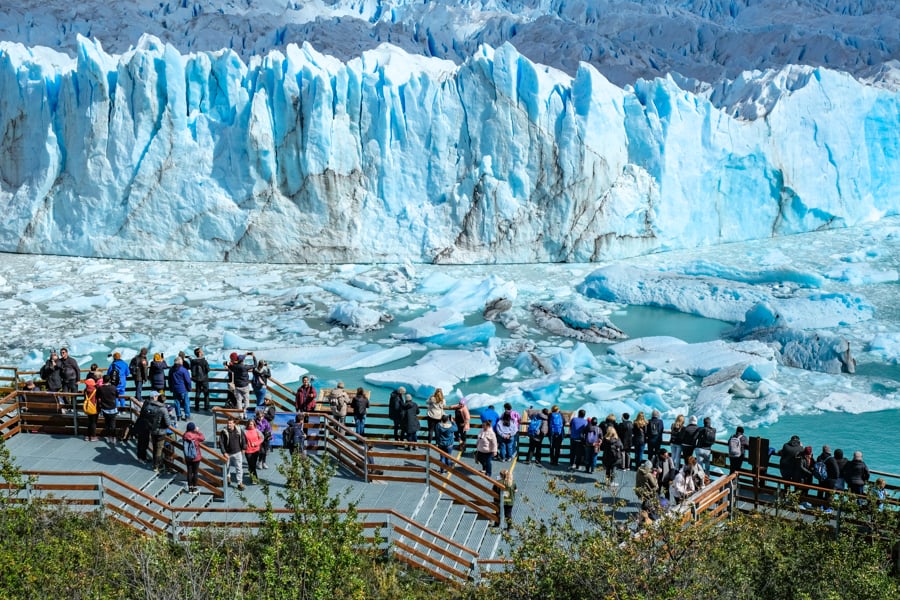
The spectacular walkway at Perito Moreno glacier
Once you arrive in El Calafate, it’s a 60-90 minute drive to Perito Moreno glacier, depending on your pace. The road is winding when you get near the end, but it’s all paved and in good condition.
If you’re driving, you can find the location on the map here, although they’ll usually ask you to park earlier and take a free shuttle the rest of the way to the glacier since there’s limited parking.
You can get to Perito Moreno with a bus, private taxi, or rental car. The bus service is offered by multiple companies with regular departures from the bus terminal in El Calafate.
If you want to simplify things even more, there are also day tours to Perito Moreno glacier from El Calafate that handle all of the transportation for you (more on that below).
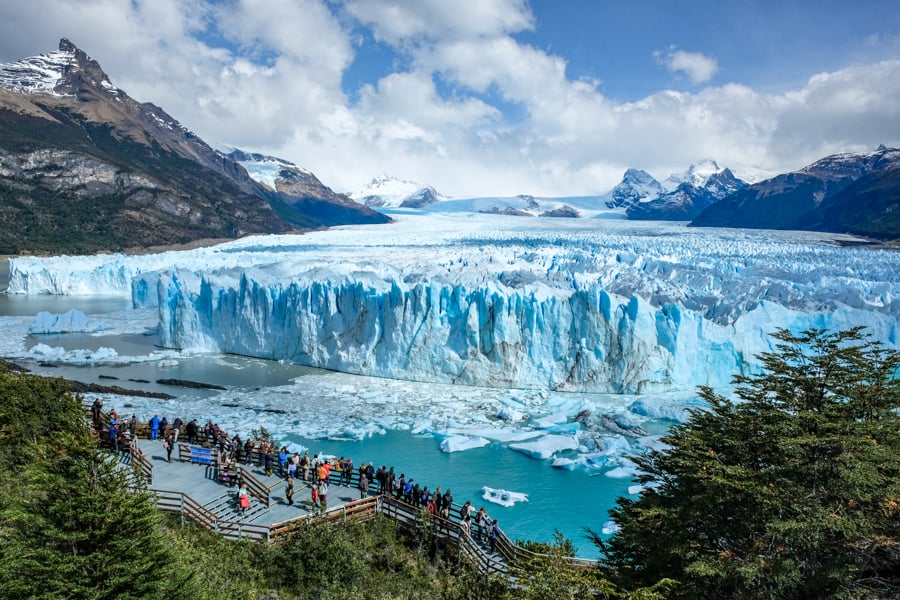
Another view of Perito Moreno glacier with the mountains in the background
Best Perito Moreno Glacier Tours
One of the easiest ways to visit the Perito Moreno glacier is with a day tour from El Calafate.
GetYourGuide has high-rated day tours to see Perito Moreno glacier from the walkway, with an optional boat cruise to see it from another angle. These tours include a bilingual tour guide and hotel pickup and drop-off from El Calafate. They’re usually shared group tours, or they also have private tours.
If you’re mainly wanting to do trekking on the ice, they have a glacier ‘mini-trekking’ tour which I used myself, and they also have the ‘Big Ice’ trek where you get to go farther and see more of Perito Moreno glacier.
If you don’t think your fitness level is good enough for hiking on the ice, they have a ‘Safari Azul’ tour that takes you to a beach in front of the glacier, where you can touch the ice and see it up close without trekking on it. Last, but not least, they also have kayaking tours and boat cruises at the Perito Moreno glacier.
We’ve used GetYourGuide for lots of tours and activities around the world, and they’re great. Highly recommended!
Book Now: Perito Moreno Glacier Walkway / Kayaking / Glacier Hike / Big Ice Trek
Perito Moreno Glacier Walkway: What To Expect
The most popular way to see the Perito Moreno glacier is from the metal walkway that spans the edge of Lake Argentino and its turquoise colored waters.
The views are sensational and easy to access! There’s a whole network of platforms here showing different sides of the glacier, and the walkways are divided into color coded circuits.
In my opinion, the very best views are on the red and yellow circuits. The black and green circuits don’t have much to see, although the blue circuit occasionally allows you to see some floating icebergs up close.
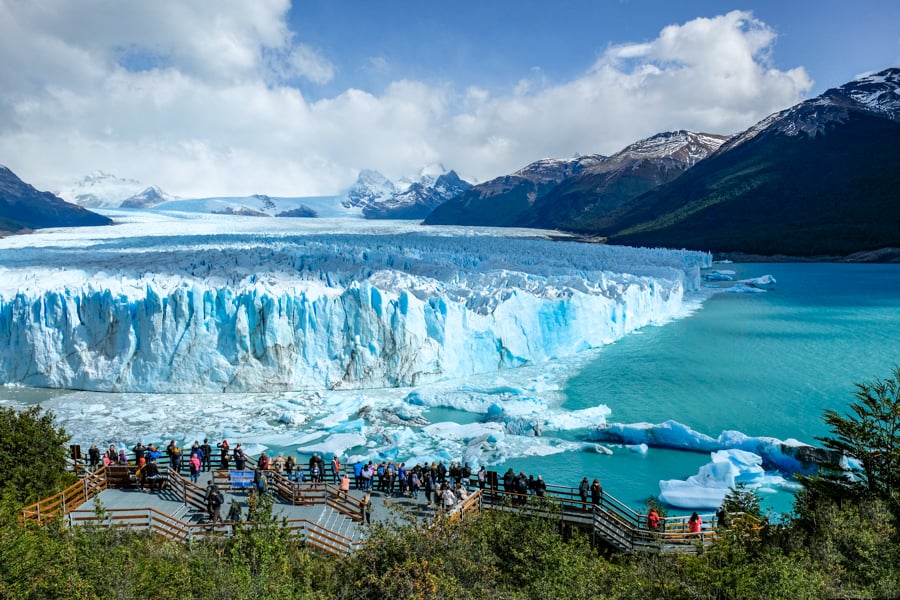
Above the Perito Moreno glacier
The views from the walkway are fantastic, and it feels like you’re really close to the glacier. Pictures don’t do it justice. It almost feels like you could reach out and touch the glacier!
There are photographers from the national park who can take your picture here for a small fee, or you can take as many photos as you want with your own phone or camera. Sometimes you’ll see giant condors flying overhead.
During the summer, you can witness ‘calving’ at Perito Moreno glacier, where big chunks of ice occasionally break off the edge of the glacier and fall into the lake with a crash.
It’s very impressive to see and hear, and if you’re quick with your camera you can sometimes catch it. The best time to visit is in the middle of the day if you want to see lots of this activity!

The wall of ice towers 75 meters above the lake surface!
The viewing platforms at Perito Moreno glacier are suitable for all ages. Some of the views are even wheelchair accessible, although the best spots are reached by stairs.
Most of the walking is pretty easy, and you can get to the last platforms with a relatively short stroll from the parking area. However, if you go down to the bottom platforms, nearest to the glacier, then you’ll have to go back up again afterwards, so it’s not without some effort.
A few hours at the glacier should be plenty of time for most people, although I think I could’ve stayed most of the day taking pictures. When you get done exploring all of the walkways, there’s a cafe, gift shop, and free bathrooms in the parking lot.
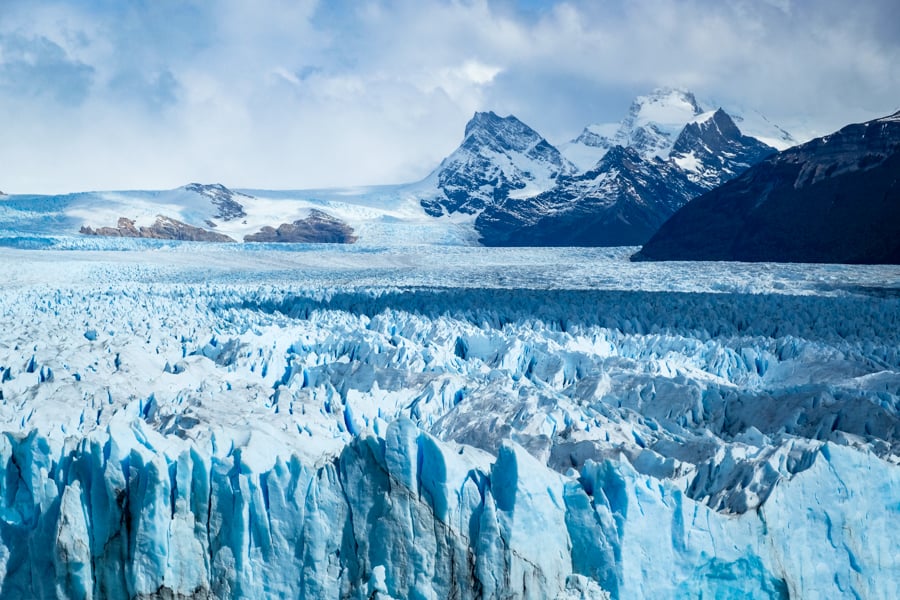
Massive blue ice field
Glacier Mini-Trekking Tour
One of the best things to do at Perito Moreno is hiking on the glacier itself!
A tour booking is required for this, and you’ll join a small group of 10 to 20 other travelers. They’ll give you a pair of spiky metal crampons to attach to the bottom of your shoes, and then you can walk on the surface of the ice with a professional guide, taking pictures as you go.
They run these tours daily, but they’re very popular and often sell out (especially in the summer months), so it’s a good idea to book it well in advance.
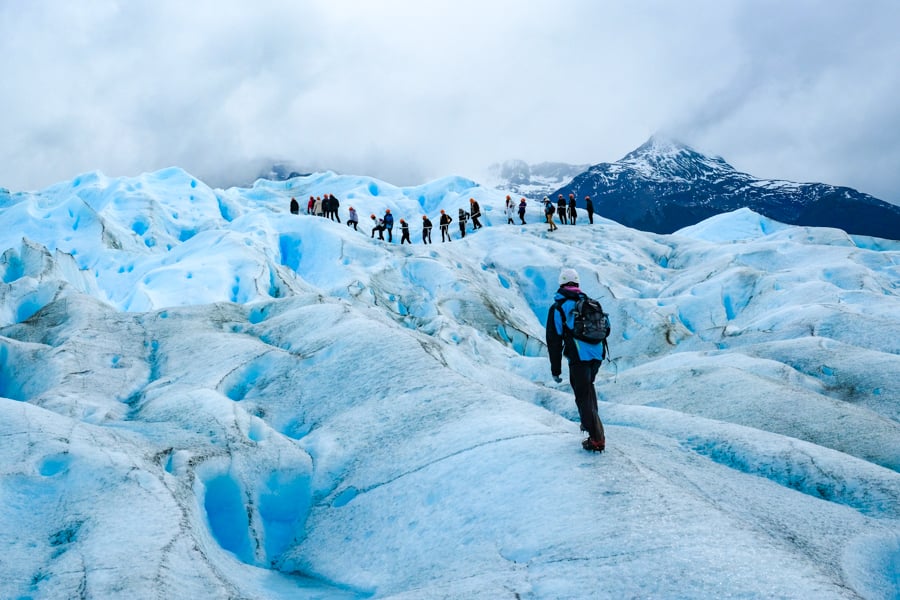
Hiking on the glacier is a must!
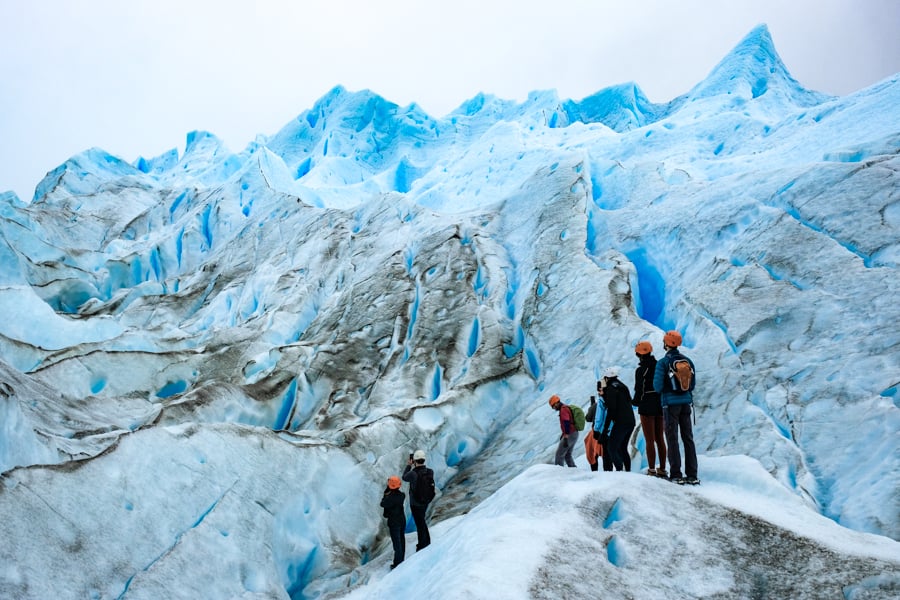
Glacier mini-trekking at Perito Moreno
According to the company, the glacier mini-trekking tour is suitable for ages 8 to 65 years old. You don’t have to be very fit to hike on the glacier, although they list obesity and some other health problems as a possible disqualifier.
The trekking guides that conduct these tours are from a company called Hielo y Aventura, and they’ve been running the glacier tours for more than 30 years without any major safety incidents. The guides are bilingual, so they speak good English and Spanish.
It’s a full day tour (up to 10 hours) since it includes driving to the national park, crossing the lake by boat, attending a short safety briefing, fitting the crampons and safety helmets, hiking on the glacier, and other activities, and then returning to El Calafate afterwards.
At the end of the tour, before leaving the glacier, they gave us complementary whiskey tumblers to drink with ice from the glacier. Fun! All in all, the Perito Moreno glacier trek is an amazing experience and you shouldn’t miss it!
Book Now: Glacier Mini-Trekking Tour
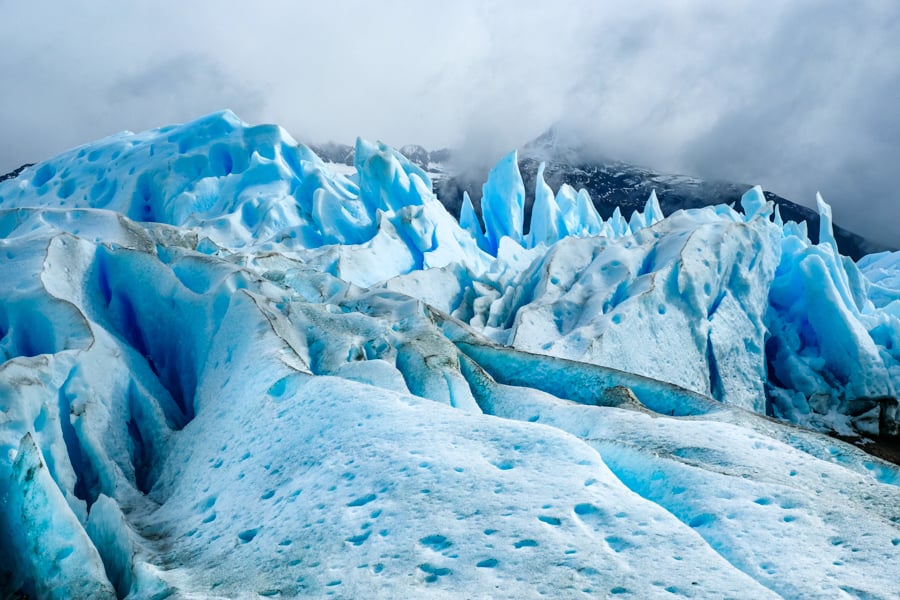
Surreal landscape
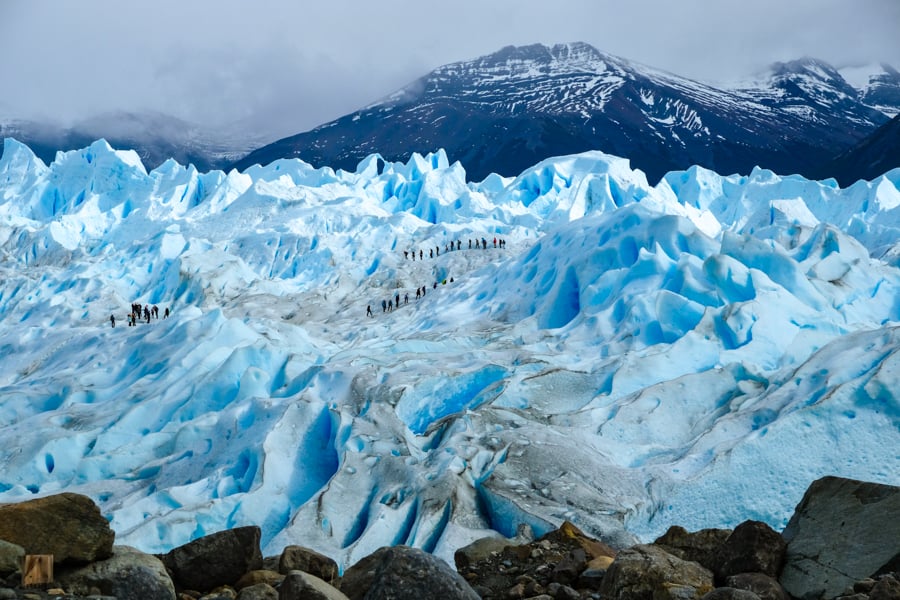
See the tiny people?
Glacier ‘Big Ice’ Trek
If you want to do even more hiking on the glacier, there’s a ‘Big Ice’ trek that goes longer and farther than the normal trek.
Compared to the mini-trekking tour, the ‘Big Ice’ trip gives you twice as much time on the glacier, so you can see more of the unique landscape, and you’ll have more time to take pictures. The tour groups are also smaller and more personalized, which is a bonus if you don’t want to go hiking with a bunch of people.
The Big Ice trek is harder, so it’s only recommended for people who are fit and ages 18 to 50 years old. It’s also more pricey. For me personally, I was happy with my decision to do the normal trek, but I’m sure I will be back at Perito Moreno someday, and then I definitely plan to do the Big Ice trek!
If you’re not a frequent visitor to Argentina and you think this may be your only chance, then it might be worth it to spring the cash for the Big Ice tour. I’m sure it’s the experience of a lifetime!
Book Now: Big Ice Glacier Trek
What To Bring For Glacier Hikes
- Outerwear: It can be very windy at the glacier, so you’ll want to bring a jacket and probably a warm winter beanie hat just in case.
- Gloves: This is a requirement for the glacier trekking tours. The reason for this is because if you happen to fall on the ice and catch yourself, the ice can be sharp enough to cut your bare hands. If you don’t have a pair of gloves, they can loan you some when you get there. I wore fingerless gloves so I could still work my camera, and that was fine.
- Footwear: Any shoes or hiking boots will work. When you trek on the glacier, crampons are provided with the tour and they can fit them to any shoe size.
- Backpack: This can be very helpful for holding any snacks, drinks, and other items you bring with you for the Perito Moreno glacier trekking tour.
- Camera: The glacier is so photogenic. A lens with a little bit of zoom is ideal, but just about any camera setup will do great here.
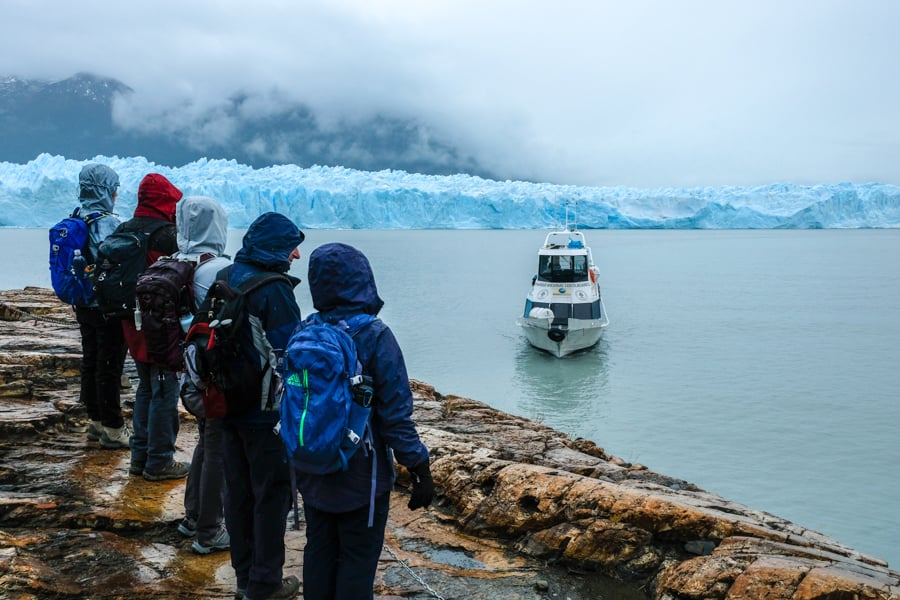
Waiting for the boat
Entrance Fee: Los Glaciares National Park
Perito Moreno is part of Argentina’s Los Glaciares National Park, so there’s a fee you have to pay to enter the park. This applies whether you’re visiting the walkway or doing other activities in the park like glacier trekking, kayaking, or boat cruises.
You can find the current park fee on the Argentina national parks website. However, if you visit two days in a row then the second day price is discounted by 50 percent. Just remember to keep your ticket so you can show them.
The park fee is something paid separate from your bus tickets or tour price, and you can pay with cash (pesos) or credit card when you reach the entrance of Los Glaciares National Park. I paid with a foreign credit card and that was fine.
You can also buy park tickets in advance on the Argentina national parks website, but it’s entirely in Spanish and the site is very glitchy. I was never able to get it to work. No worries though, because the park tickets are unlimited and never sell out, unlike the tours.
An advance booking is not required for the national park tickets, and visiting the walkway is free aside from the park entrance fee. The only thing you need to book in advance is the glacier trekking or other special activities if you plan to do them.

Perito Moreno glacier in Argentina
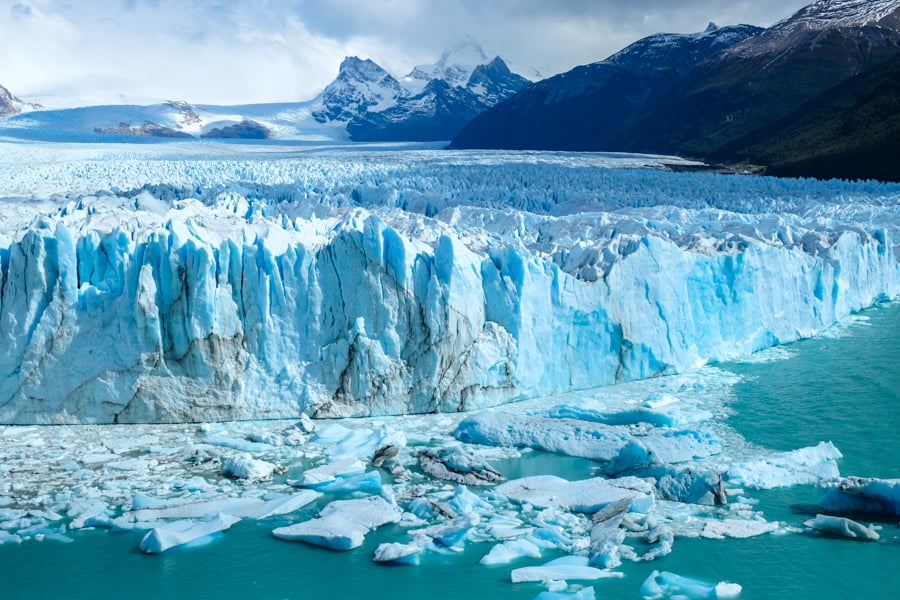
It’s easy to visit Perito Moreno glacier on a day trip from El Calafate
Fun Facts About Perito Moreno Glacier
- How big is it?
The glacier is 30 kilometers long (almost 19 miles), and it covers a total area of 250 square kilometers (100 mi²), making it bigger than the Argentine capital city of Buenos Aires. The wall of ice towers over Lago Argentino, with an average height of 75 meters (250 ft) above the surface of the lake.
- Why is it blue?
Pure glacier ice is blue because it’s so dense and compressed, with the air bubbles squeezed out from the ice. As a result, it reflects the blue colors of the light spectrum, and a beautiful blue color reaches our eyes. It’s a lot different from the frozen water you get out of the freezer.
- What is the source?
The glacier is part of the Southern Patagonian Ice Field, which is the world’s second largest contiguous extrapolar ice field, and one of the world’s biggest reserves of fresh water.
- How did it get its name?
The Perito Moreno glacier was named after a 19th century Argentine explorer, Francisco Moreno, who was influential in the Patagonia region. ‘Perito’ in Spanish is a title of respect that means ‘expert’ or ‘specialist.’
- Is there more than one Perito Moreno in Argentina?
Yes. Somewhat confusingly, there’s a national park named Perito Moreno in Argentina, but it’s located far away from this glacier. There’s also a town named Perito Moreno, but it’s located almost 700 kilometers from the glacier. This threw me for a loop one time when I was buying bus tickets from El Calafate. The Perito Moreno town, glacier, and national park are three very different places! If you’re looking for Perito Moreno glacier on a map, you can find it here.
- Is the glacier melting or shrinking?
Unlike most glaciers around the world, Perito Moreno is not shrinking. This glacier is unusual because it’s actually advancing and moving forward by up to 2 meters (6 feet) per day, although the overall mass stays in balance because of the chunks of ice it loses from calving and ruptures.
- What is the rupture?
Because of its constant advance, the Perito Moreno glacier sometimes forms a dam at the edge of Lake Argentino, blocking off the southern arm of the lake (Brazo Rico) and causing the water level to rise and put tremendous pressure on the glacier. Eventually, this leads to a spectacular rupture of the glacial dam, and huge chunks of ice fall into the lake. The rupture happens every 3 to 5 years, but it’s completely unpredictable, so you would be lucky to witness it!
- What is calving?
Calving is when big chunks of ice occasionally break off the edge of the Perito Moreno glacier and fall into the lake with a crash. On a good day, this can happen as often as every 30 minutes, and afternoon is the best time to see it. It’s an amazing sight!
- What is the UNESCO status?
The Perito Moreno glacier is part of Los Glaciares National Park, which has been recognized as a UNESCO World Heritage Site since 1981. This is because of its outstanding natural significance and beauty.
- How hard is it to get to Perito Moreno glacier from El Calafate?
It’s easy to get to Perito Moreno glacier from anywhere in the town of El Calafate. You can get there with the bus, take a private taxi, rent a car, or book a tour.
- How can you hike on the Perito Moreno glacier?
There’s a glacier mini-trek or a ‘Big Ice’ trek. The Big Ice hike is longer and better, but it’s harder and more expensive. Most people will probably be happy with the mini trek. It’s a fantastic experience.
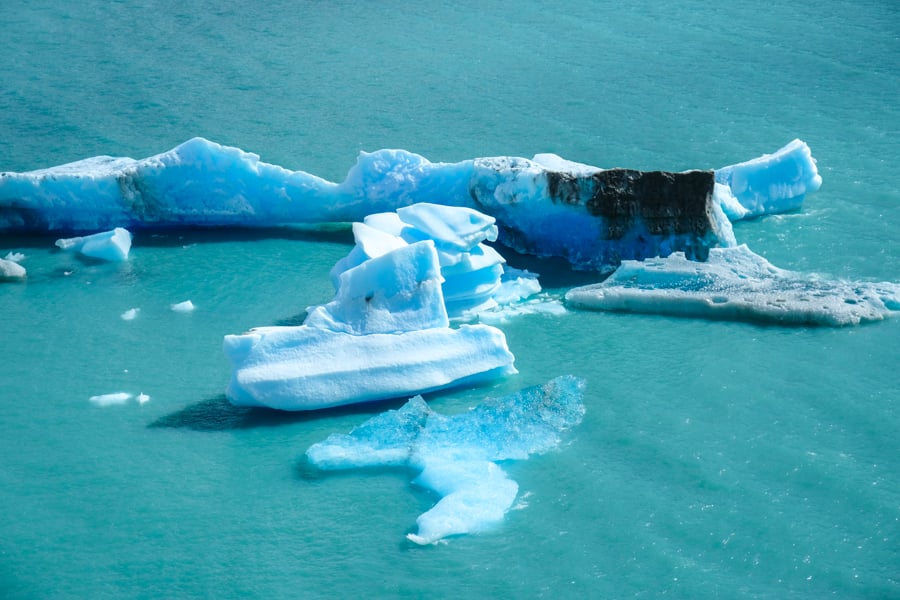
Floating icebergs on the lake
Best Time To Visit Patagonia
The best time to visit Perito Moreno glacier is in the spring, summer, or fall. The summer months run from December to February, and these months have some of the longest days and best hiking weather, but they’re also more popular and expensive.
The shoulder months of March, April, and November can also be great, although the temperatures may be a bit cooler. All of the pictures in this travel guide were taken in mid-March, which seemed just about perfect to me.
It’s possible to visit the glacier during the winter, but a lot of the tours like glacier trekking and kayaking don’t run at that time, so you’ll be more limited in what you can do. Boat cruises still run, and the glacier is still spectacular. The park is also less crowded and prices are cheaper than normal, so that’s one upside of visiting in the winter.
There’s really no best time of day to visit the glacier. It’s fantastic at any time of day. You may be able to avoid some of the crowds in the morning or late afternoon, although the best lighting for photographs is generally around late morning or early afternoon. The glacier can be backlit by the sun in the evening, so that’s not ideal for photos.
If you want to witness the calving activity where big chunks of ice fall into the lake with a boom, the best time is near the middle of the day, when the temperatures are warmest. Any time in the afternoon is great for that.
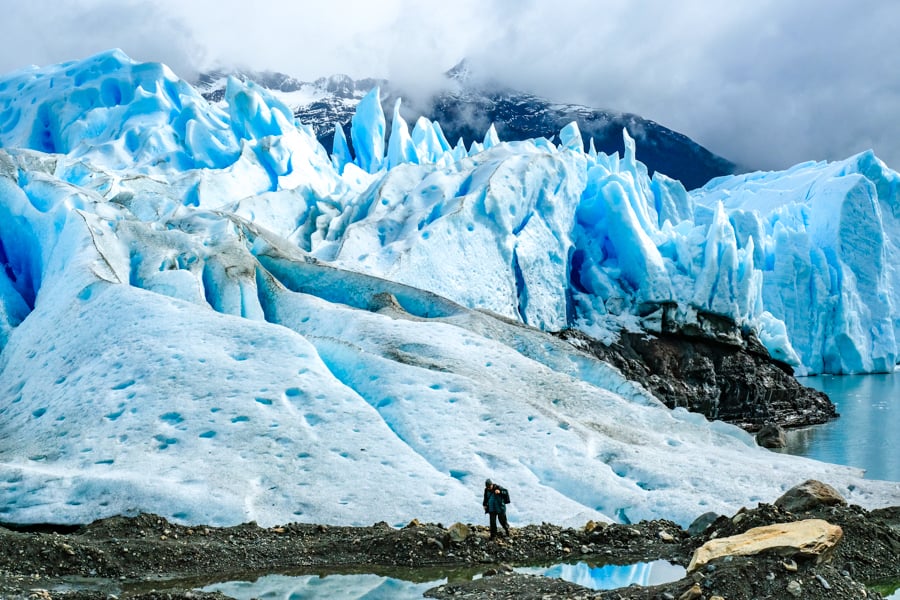
It looks like another planet
Other Patagonia Glacier Tours
If you want to see more glaciers in El Calafate and the Patagonia region, check out the Upsala and Spegazzini glaciers! These ones are only accessible with a boat tour.
The Spegazzini glacier is notable for being the highest glacier in the national park. Its ice towers over the surface of the lake by a whopping 135 meters (440 feet)! In the same area, you can also see the hanging glaciers of Dry, Heim Sur, and Peineta.
Alternatively, you can hike to Lake Frias, which is a lake filled with floating icebergs, and there you can see the Dickson, Cubo, and Grande glaciers. It’s a great way to witness some of Patagonia’s less known glaciers!
GetYourGuide has high-rated tours that visit these glaciers on a day trip from El Calafate, with the boat cruise and other transportation included. You can find out more in the links below.
Book Now: Upsala & Spegazzini Glaciers / Lake Frias Tour
Other Tips For El Calafate Town
- Hotels: There are a bunch of comfortable hotels and hostels in El Calafate town. Check out Calafate Hostel for a budget option, Kau Yatun Boutique for midrange, and Xelena Hotel for high end.
- Restaurants: The town has lots of good places to eat. A nice breakfast option is Pietro’s Cafe, and for dinner check out La Tablita or Isabel Cocina al Disco.
- Credit Cards: Most places in town accept credit cards, but some may be cash only. Bring enough cash just in case. The ATMs in town are not very reliable.
- Money Changers: You can find money changers (‘cambio’) in El Calafate with good rates. I changed US Dollars to Argentine Pesos at the Arte Indio souvenir shop near the town center.
- WiFi: The hotels and restaurants in El Calafate usually have fast, reliable WiFi. I was able to find great WiFi everywhere I went in town.
- Cell Service: With T-Mobile roaming, I had good cell service/phone reception from Claro in El Calafate town. Staying in touch with home is no problem at all here.
- Supplies: There are plenty of grocery and convenience stores in El Calafate, as well as shops where you can buy or rent tents, sleeping bags, backpacks, jackets, and all kinds of other equipment for camping and hiking. I’m sure it’s more pricey than bringing your own gear, though, so do that if you can.
- Safety: Argentina is a pretty safe country overall, and the Patagonia region is especially safe. Generally you don’t have to worry about crime in El Calafate. Just practice normal precautions. Don’t leave cash in your room, or valuables in your car.
More Patagonia Travel Tips
Thanks for looking! I hope you enjoyed this travel guide for the Perito Moreno glacier walkway and trekking tours in Patagonia, Argentina.
Don’t forget to check out my blog post for the amazing Mount Fitz Roy hike and Laguna De Los Tres, in the nearby town of El Chalten. I also wrote a separate guide for the Iguazu Falls in Argentina.
Happy travels!
Leave a reply















